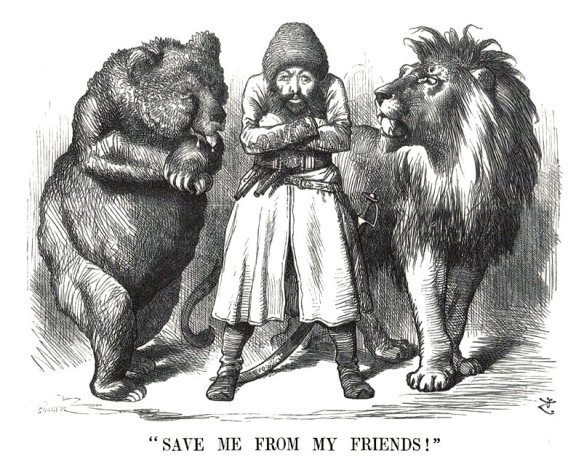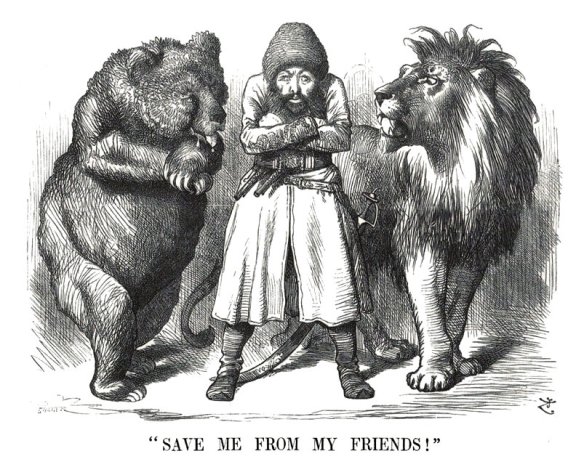In 1839, Arthur Connolly, an intelligence officer with the East India Company, described the competition between Great Britain and Russia for control of Central Asia as “the grand game,” and the phrase became widely popular as “the great game” after writer Rudyard Kipling used it in Kim, a novel published in 1901. The rivalry dated from 1813, when (after a lengthy conflict) the Russians forced Persia to accept their control of much territory in the Caucasus Mountains region, including the area covered by modern Azerbaijan, Dagestan, and eastern Georgia. British politicians feared that the tsars’ expansionist ambitions would carry them further south and threaten the commercially and strategically important imperial possessions in India so the government attempted to make Afghanistan a buffer state that would prevent Russian armies from attacking through the Bolan and Khyber Passes in the Himalayas. In the early 20th century, the struggle extended to Persia and Tibet, but by then both powers considered Germany a growing threat so on 31 August 1907, in St. Petersburg, they signed an entente that circumscribed their areas of influence in Persia and ended Russian contacts with the Afghans. In 1917, the communist revolution changed the nature of power in Russia and in 1919 Britain ended Afghanistan’s protectorate status, leaving the Afghan leaders free to sign a treaty of friendship with the Soviet Union in 1921. For 20 years, both sides continued to woo the Afghan rulers, but World War II led to cooperation, rather than competition, and ended the struggle for influence.
While Russia expanded into Central Asia in the early years of the 19th century, British governments worried that its tsars would use Afghanistan as a base for launching attacks on imperial possessions in India. As early as 1809, Great Britain negotiated a defense treaty with Shuja Shah Durrani, the self-proclaimed king of Afghanistan, in the hope of deterring potential aggressors. Soon afterward, Shuja was deposed, but in 1839 Britain used East India Company troops to restore him to the throne, primarily because the governor-general of India, George Eden, earl of Auckland, believed that the installation of a puppet ruler over the lands to the north of the Bolan and Khyber Passes would prevent Russia from advancing southward through the Himalayan Mountains. However, most Afghans resented both the foreign army and the monarch it imposed on them. In November and December 1841, that resentment flared into violence when several British officials were murdered, but to the disgust of his officers, Major-General William Elphinstone, the officer in charge of the army garrison in Kabul (the Afghan capital), failed to punish the culprits or take any other action until 6 January 1842, when he ordered a withdrawal. The 4,500 soldiers and their 12,000 administrative personnel and dependents headed for Jalalabad, some 90 miles away, but were trapped by tribesmen and massacred. Later in the year, troops led by Major-Generals William Nott and George Pollock exacted reprisals, burning stock and villages and destroying the bazaar in Kabul before retiring to India, but, even so, the imperial power’s image of invincibility was badly dented.
Despite the loss of prestige, many politicians in Britain (and particularly those in the Liberal Party) continued to consider Afghanistan an important buffer between tsarist expansion and British interests on the Indian subcontinent (1804–1881)). That world-view led to a second conflict in 1878–1880 after Sher Ali Khan, the emir of Afghanistan, refused to meet a British diplomatic mission because he wanted to maintain a policy of political neutrality rather than align with any major European power. Britain responded with a 40,000- strong invasion force that left Mohammed Yaqub Khan (the emir’s son and successor) with no option but to sign a treaty, on 26 May 1879, that made his country a British protectorate, surrendering all rights to negotiate with foreign governments and ceding territory in return for assistance to resist aggressors “in whatsoever manner the British government may judge best.” Following a rebellion later in the year, Britain replaced Yaqub Khan with his cousin, Abdur Rahman Khan.
For nearly four decades after that conflict ended, British officials maintained cordial relations with the Afghan leaders, who seemed willing to accept the restrictions on their external relations in return for financial help and freedom of control over domestic matters. However, in 1919, Amanullah Khan, Abdur Rahman Khan’s grandson (who had assumed control of the country after his father, Habibullah Khan, was assassinated in February of the same year), took advantage of political uncertainties caused by the Bolshevik revolution in Russia and by civil unrest in Britain’s Indian Empire to build support for his rule by promising to make his country fully independent of British influence. On 3 May, he marched his army through the Khyber Pass and occupied the strategically important village at Bagh (now in Pakistan). British and Indian troops recaptured the settlement on 11 May then pressed on into Afghanistan, supported by aircraft that bombed Jalala- bad and Kabul. Amanullah sued for peace on 31 May, but Great Britain, its armies much weakened by the effects of World War I, was in no mood to assert itself. On 8 August, at Rawalpindi, it recognized Afghanistan’s independence and gave assurances that it would not attempt to extend its Empire north of the Khyber Pass. Even so, independent-minded tribesman continued to cause problems for Britain along the northwest frontier between India and Afghanistan, and those problems were inherited by Pakistan when it became independent in 1947.

